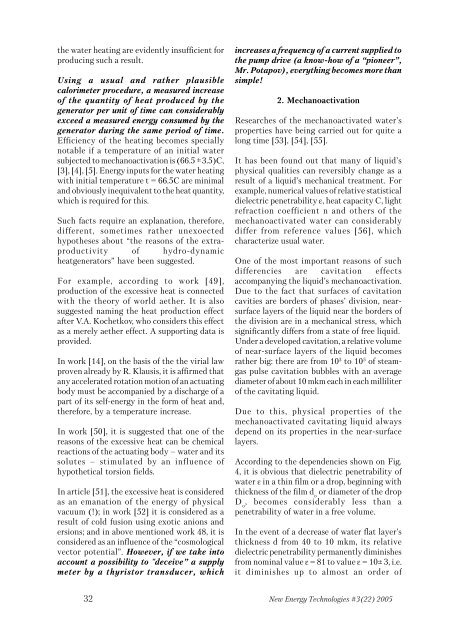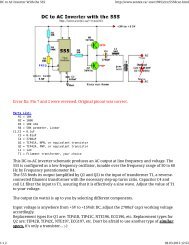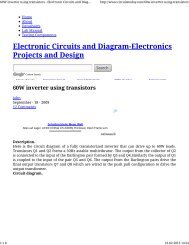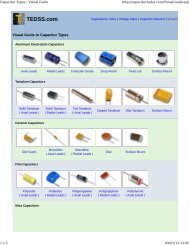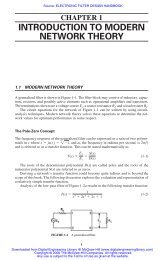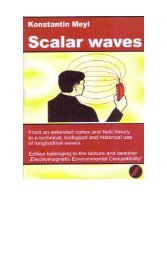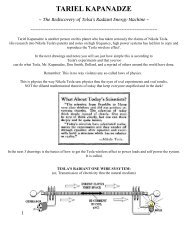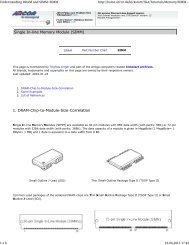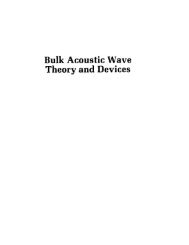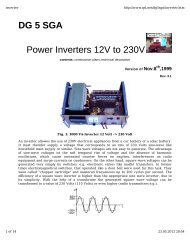New Energy Technologies Magazine nr 3 2005.pdf - Index of
New Energy Technologies Magazine nr 3 2005.pdf - Index of
New Energy Technologies Magazine nr 3 2005.pdf - Index of
Create successful ePaper yourself
Turn your PDF publications into a flip-book with our unique Google optimized e-Paper software.
the water heating are evidently insufficient for<br />
producing such a result.<br />
Using a usual and rather plausible<br />
calorimeter procedure, a measured increase<br />
<strong>of</strong> the quantity <strong>of</strong> heat produced by the<br />
generator per unit <strong>of</strong> time can considerably<br />
exceed a measured energy consumed by the<br />
generator during the same period <strong>of</strong> time.<br />
Efficiency <strong>of</strong> the heating becomes specially<br />
notable if a temperature <strong>of</strong> an initial water<br />
subjected to mechanoactivation is (66.5 3.5)C,<br />
[3], [4], [5]. <strong>Energy</strong> inputs for the water heating<br />
with initial temperature t = 66.5C are minimal<br />
and obviously inequivalent to the heat quantity,<br />
which is required for this.<br />
Such facts require an explanation, therefore,<br />
different, sometimes rather unexoected<br />
hypotheses about “the reasons <strong>of</strong> the extraproductivity<br />
<strong>of</strong> hydro-dynamic<br />
heatgenerators” have been suggested.<br />
For example, according to work [49],<br />
production <strong>of</strong> the excessive heat is connected<br />
with the theory <strong>of</strong> world aether. It is also<br />
suggested naming the heat production effect<br />
after V.A. Kochetkov, who considers this effect<br />
as a merely aether effect. A supporting data is<br />
provided.<br />
In work [14], on the basis <strong>of</strong> the the virial law<br />
proven already by R. Klausis, it is affirmed that<br />
any accelerated rotation motion <strong>of</strong> an actuating<br />
body must be accompanied by a discharge <strong>of</strong> a<br />
part <strong>of</strong> its self-energy in the form <strong>of</strong> heat and,<br />
therefore, by a temperature increase.<br />
In work [50], it is suggested that one <strong>of</strong> the<br />
reasons <strong>of</strong> the excessive heat can be chemical<br />
reactions <strong>of</strong> the actuating body – water and its<br />
solutes – stimulated by an influence <strong>of</strong><br />
hypothetical torsion fields.<br />
In article [51], the excessive heat is considered<br />
as an emanation <strong>of</strong> the energy <strong>of</strong> physical<br />
vacuum (!); in work [52] it is considered as a<br />
result <strong>of</strong> cold fusion using exotic anions and<br />
ersions; and in above mentioned work 48, it is<br />
considered as an influence <strong>of</strong> the “cosmological<br />
vector potential”. However, if we take into<br />
account a possibility to "deceive” a supply<br />
meter by a thyristor transducer, which<br />
increases a frequency <strong>of</strong> a current supplied to<br />
the pump drive (a know-how <strong>of</strong> a “pioneer”,<br />
Mr. Potapov), everything becomes more than<br />
simple!<br />
2. Mechanoactivation<br />
Researches <strong>of</strong> the mechanoactivated water’s<br />
properties have being carried out for quite a<br />
long time [53], [54], [55].<br />
It has been found out that many <strong>of</strong> liquid’s<br />
physical qualities can reversibly change as a<br />
result <strong>of</strong> a liquid’s mechanical treatment. For<br />
example, numerical values <strong>of</strong> relative statistical<br />
dielectric penetrability ε, heat capacity C, light<br />
refraction coefficient n and others <strong>of</strong> the<br />
mechanoactivated water can considerably<br />
differ from reference values [56], which<br />
characterize usual water.<br />
One <strong>of</strong> the most important reasons <strong>of</strong> such<br />
differencies are cavitation effects<br />
accompanying the liquid’s mechanoactivation.<br />
Due to the fact that surfaces <strong>of</strong> cavitation<br />
cavities are borders <strong>of</strong> phases’ division, nearsurface<br />
layers <strong>of</strong> the liquid near the borders <strong>of</strong><br />
the division are in a mechanical stress, which<br />
significantly differs from a state <strong>of</strong> free liquid.<br />
Under a developed cavitation, a relative volume<br />
<strong>of</strong> near-surface layers <strong>of</strong> the liquid becomes<br />
rather big: there are from 10 3 to 10 5 <strong>of</strong> steamgas<br />
pulse cavitation bubbles with an average<br />
diameter <strong>of</strong> about 10 mkm each in each milliliter<br />
<strong>of</strong> the cavitating liquid.<br />
Due to this, physical properties <strong>of</strong> the<br />
mechanoactivated cavitating liquid always<br />
depend on its properties in the near-surface<br />
layers.<br />
According to the dependencies shown on Fig.<br />
4, it is obvious that dielectric penetrability <strong>of</strong><br />
water ε in a thin film or a drop, beginning with<br />
thickness <strong>of</strong> the film d o<br />
or diameter <strong>of</strong> the drop<br />
D o<br />
, becomes considerably less than a<br />
penetrability <strong>of</strong> water in a free volume.<br />
In the event <strong>of</strong> a decrease <strong>of</strong> water flat layer’s<br />
thickness d from 40 to 10 mkm, its relative<br />
dielectric penetrability permanently diminishes<br />
from nominal value ε = 81 to value ε = 10 3, i.e.<br />
it diminishes up to almost an order <strong>of</strong><br />
32 <strong>New</strong> <strong>Energy</strong> <strong>Technologies</strong> #3(22) 2005


